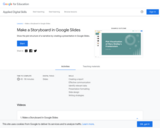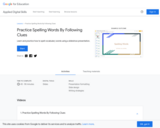
Create a pixel art project using conditional formatting in a spreadsheet. Time to complete: 45-90 minutes
- Subject:
- Arts
- Technology
- Material Type:
- Lesson
- Lesson Plan
- Provider:
- Provider Set:
- Applied Digital Skills
- Date Added:
- 05/03/2022

Create a pixel art project using conditional formatting in a spreadsheet. Time to complete: 45-90 minutes

Show the plot structure of a narrative by creating a presentation in Google Slides. Time to complete: 45-90 minutes

It's tempting to assume that technology is the key when it comes to reaching your audience and engaging them. However, creativity and innovation trump purely technological choices. This article explains the role of each in successfully marketing a product. (Published Oct. 24, 2019)

Self-direction is one of the most powerful skills anyone can develop. In today's world of high stakes testing and educational pressure, here are some ways to encourage the development of self-direction in learning.

An excellent interactive site which allows students to take notes as well as organize, plan, and revise their writing, as well as assist with reading skills. Provides several options for student creativity and improvement concerning notetaking skills.

Learn and practice how to spell vocabulary words using a slideshow presentation. Time to complete: 45-90 minutes

These weekly activities are cross-curricular but emphasize Social-Emotional Learning, Math, and Literacy development. This week we learn that art communicates ideas and feelings.

These weekly activities are cross-curricular but emphasize Social-Emotional Learning, Math, and Literacy development. This week (January 4th), we are working on problem-solving.m

Psychology is designed to meet scope and sequence requirements for the single-semester introduction to psychology course. The book offers a comprehensive treatment of core concepts, grounded in both classic studies and current and emerging research. The text also includes coverage of the DSM-5 in examinations of psychological disorders. Psychology incorporates discussions that reflect the diversity within the discipline, as well as the diversity of cultures and communities across the globe.Senior Contributing AuthorsRose M. Spielman, Formerly of Quinnipiac UniversityContributing AuthorsKathryn Dumper, Bainbridge State CollegeWilliam Jenkins, Mercer UniversityArlene Lacombe, Saint Joseph's UniversityMarilyn Lovett, Livingstone CollegeMarion Perlmutter, University of Michigan


By the end of this section, you will be able to:
Define intelligence
Explain the triarchic theory of intelligence
Identify the difference between intelligence theories
Explain emotional intelligence

This website offers a printable book review template that can be used to guide students in writing book reviews. The template includes prompts for summarizing the book, identifying the main characters, and offering a personal opinion.

This rubric from ReadWriteThink can be used to evaluate student created book trailers and includes criteria for assessing the quality of the trailer's content, production value, and effectiveness in generating interest in the book.

Abby and Elmo use their imagination and play pretend! They pretend they're space monkeys with brown fur and long tails. This video focuses on imaginative play.

Watch this video to learn about a variety of modes of transportation to get from point a to point b from Big Bird, Abby, Telly, and Elmo. [3:58]

Create a slideshow presentation to show your appreciation for a teacher, coach, or friend. Time to complete: 45-90 minutes

Students apply the mechanical advantages and problem-solving capabilities of six types of simple machines (wedge, wheel and axle, lever, inclined plane, screw, pulley) as they discuss modern structures in the spirit of the engineers and builders of the great pyramids. While learning the steps of the engineering design process, students practice teamwork, creativity and problem solving.

StoryMaker is a free learning platform powered by PBS NewsHour Student Reporting Labs. It is your one-stop shop for projects, tutorials, and lesson plans connected to media making, digital journalism, and public broadcasting.

Brute computing force alone can't solve the world's problems. Data mining innovator Shyam Sankar explains why solving big problems is not a question of finding the right algorithm, but rather the right symbiotic relationship between computation and human creativity. [12:13]

Rather than have a purpose, unstructured play is child-led, often leading to play that is creative and improvised. This article discusses the importance of unstructured play and gives tips on how to help children get this most our of unstructured playtime.